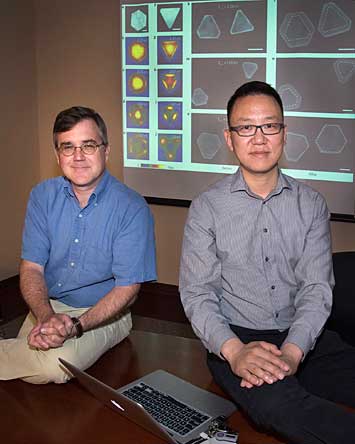Setting the Gold Standard
UF chemistry professor is first to use light to make gold crystal nanoparticles
July 12, 2016
This news release was issued on July 6, 2016 by the University of Florida (UF). Eric Stach, leader of the Electron Microscopy Group at the U.S. Department of Energy's (DOE) Brookhaven National Laboratory, Brookhaven Lab scientist Dong Su, and Brookhaven Lab former postdoctoral researcher Aaron Johnston-Peck contributed to the research. They conducted electron microscopy studies at Brookhaven's Center for Functional Nanomaterials, a DOE Office of Science User Facility, to reveal how nanoscale optical properties affect the growth of gold nanoprisms.
 enlarge
enlarge
Electron Microscopy Group Leader Eric Stach (left) and scientist Dong Su at Brookhaven's Center for Functional Nanomaterials, where they used scanning transmission electron microscopy to show how optical properties at the nanoscale influence the growth of gold nanoprisms. In the background are maps that show the local electronic response to an applied stimulus (in this case, electron flux), in both a single gold hexagonal nanoprism (left column) and a single gold triangular nanoprism (right column). As shown in the images on the right, crystal growth is not affected by this local electrical response, in contrast to prior predictions. This information was critical to developing the model of crystal growth for gold nanoprisms under intense optical illumination.
GAINESVILLE, Fla.—A team of University of Florida (UF) researchers has figured out how gold can be used in crystals grown by light to create nanoparticles, a discovery that has major implications for industry and cancer treatment and could improve the function of pharmaceuticals, medical equipment, and solar panels.
Nanoparticles can be "grown" in crystal formations with special use of light in a process called plasmon-driven synthesis. However, scientists have had limited control unless they used silver, but silver limits the uses for medical technology. The team is the first to successfully use gold, which works well within the human body, with this process.
"How does light actually play a role in the synthesis? [This knowledge] was not well developed," said David Wei, an associate professor of chemistry who led the research team. "Gold was the model system to demonstrate this."
Gold is highly desired for nanotechnology because it is malleable, does not react with oxygen, and conducts heat well. These properties make gold an ideal material for nanoparticles, especially those that will be placed in the body.
When polyvinylpyrrolidone, or PVP, a substance commonly found in pharmaceutical tablets, is used in plasmon-driven synthesis, it enables scientists to better control the growth of crystals. In Wei's research, PVP surprised the team by showing its potential to relay light-generated "hot" electrons to a gold surface to grow the crystals.
The research describes the first plasmonic synthesis strategy that can make high-yield gold nanoprisms. Even more exciting, the team has demonstrated that visible-range and low-power light can be used in the synthesis. Combined with nanoparticles being used in solar photovoltaic devices, this method can even harness solar energy for chemical synthesis to make nanomaterials or for general applications in chemistry.
Wei has spent the last decade working in nanotechnology. He is intrigued by its applications in photochemistry and biomedicine, especially in targeted drug delivery and photothermal therapeutics, which is crucial to cancer treatment. His team includes collaborators from the Department of Energy's (DOE) Pacific Northwest National Laboratory, where he has worked as a visiting scholar, and DOE's Brookhaven National Laboratory. In addition, the project has provided an educational opportunity for chemistry students: one high school student (through UF's Student Science Training Program), two University scholars funded by the Howard Hughes Medical Institute, five graduate students, and two postdocs.
The research was supported by the Air Force Office of Science Research and National Science Foundation.
Brookhaven National Laboratory is supported by the Office of Science of the U.S. Department of Energy. The Office of Science is the single largest supporter of basic research in the physical sciences in the United States, and is working to address some of the most pressing challenges of our time. For more information, please visit science.energy.gov.
2016-11853 | INT/EXT | Newsroom









